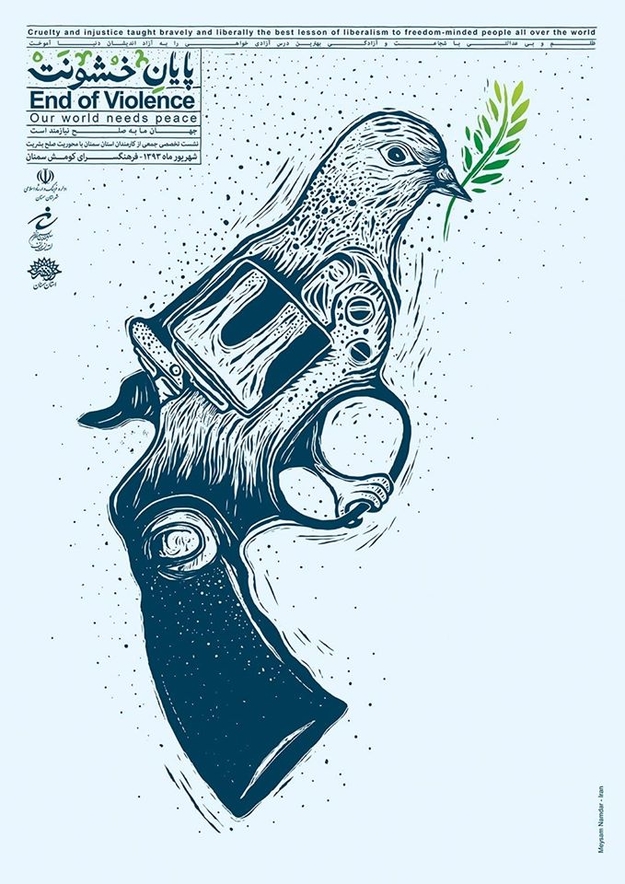By poster : Meysam Namdar
August 2014 – Iran - semnan
Django Slhast nonstop cycle of human history. Always with the awful sound of the trumpet, the war started with the white Tkhparchhay elements, brings peace to come. Among the many wars and massacres Slhha humans and animals, trees, plants, land, water and far from gone. And since the "war" and "Ethics" - like water and oil do not mix with each other - never next to each other are not the result of war is nothing but an increase in theft, abuse of women and children, kidnapping, starvation, famine, disease, loneliness and human suffering. . . What was said was clear to all of us and requires no further elaboration. But what of war and the art of how to connect the artwork is a reflection of the war. The question is how wars throughout history were reflected in art? And the other question of when and by whom was the common way of reflecting the artwork?
*
تاریخ بشر چرخهي بدون توقف جنگ و صلحاست. همواره با صداي مهيب شيپوري، جنگي آغاز شده و با به اهتزاز درآمدن تکهپارچهاي سفيد، صلحي به ارمغان آمده است. و در ميان اين جنگها و صلحها انسانهاي بسياري قتلعام شده و حيوانات، درختان، گياهان، زمين، آب و موجودات بسياري از بين رفتهاند. و از آنجا که «جنگ» و «اخلاق» - مانند آب و روغن كه با يكديگر مخلوط نميشوند - هيچگاه با يكديگر كنار نميآيند، حاصل اين جنگها چيزي نبوده است جز افزايش دزدي، سو استفاده از زنان و كودكان، آدم ربايي، گرسنگي،قحطي، بيماري، تنهايي و دردهاي انساني . . . آنچه گفته شد بر همهي ما روشن بوده و نياز به توضيح بيشتري ندارد. اما آنچه جنگ و هنر را به يكديگر ارتباط ميدهد نحوهي بازتاب جنگ در آثار هنري است. پس پرسش اين است كه جنگها در طول تاريخ چگونه در آثار هنري منعكس ميشدند؟ و پرسش ديگر اينكه از چه زماني و توسط چه كساني شيوهاي ديگر از انعكاس جنگ در آثار هنري مرسوم شد؟

meysam-namdar - End of Violence
By poster : Meysam Namdar
August 2014 – Iran - semnan
Django Slhast nonstop cycle of human history. Always with the awful sound of the trumpet, the war started with the white Tkhparchhay elements, brings peace to come. Among the many wars and massacres Slhha humans and animals, trees, plants, land, water and far from gone. And since the "war" and "Ethics" - like water and oil do not mix with each other - never next to each other are not the result of war is nothing but an increase in theft, abuse of women and children, kidnapping, starvation, famine, disease, loneliness and human suffering. . . What was said was clear to all of us and requires no further elaboration. But what of war and the art of how to connect the artwork is a reflection of the war. The question is how wars throughout history were reflected in art? And the other question of when and by whom was the common way of reflecting the artwork?
*
تاریخ بشر چرخهي بدون توقف جنگ و صلحاست. همواره با صداي مهيب شيپوري، جنگي آغاز شده و با به اهتزاز درآمدن تکهپارچهاي سفيد، صلحي به ارمغان آمده است. و در ميان اين جنگها و صلحها انسانهاي بسياري قتلعام شده و حيوانات، درختان، گياهان، زمين، آب و موجودات بسياري از بين رفتهاند. و از آنجا که «جنگ» و «اخلاق» - مانند آب و روغن كه با يكديگر مخلوط نميشوند - هيچگاه با يكديگر كنار نميآيند، حاصل اين جنگها چيزي نبوده است جز افزايش دزدي، سو استفاده از زنان و كودكان، آدم ربايي، گرسنگي،قحطي، بيماري، تنهايي و دردهاي انساني . . . آنچه گفته شد بر همهي ما روشن بوده و نياز به توضيح بيشتري ندارد. اما آنچه جنگ و هنر را به يكديگر ارتباط ميدهد نحوهي بازتاب جنگ در آثار هنري است. پس پرسش اين است كه جنگها در طول تاريخ چگونه در آثار هنري منعكس ميشدند؟ و پرسش ديگر اينكه از چه زماني و توسط چه كساني شيوهاي ديگر از انعكاس جنگ در آثار هنري مرسوم شد؟